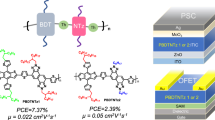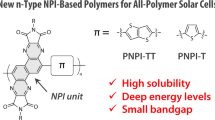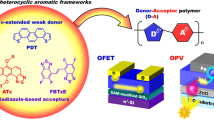Abstract
To improve the strong aggregation behavior and molecular orientation of the previously reported polymer PFE4T with vinylene-bridged 5,6-difluorobenzo[c][1,2,5]thiadiazole (FBTzE), we designed and synthesized a vinylene-bridged 5-alkoxy-6-fluorobenzo[c][1,2,5]thiadiazole (FOBTzE) moiety as a novel electron acceptor unit and its copolymer PFOE4T. By installing a strong electron-donating alkoxy group into the FBTzE framework instead of an electron-withdrawing fluorine atom, the highest occupied molecular orbital (HOMO) energy level of the resulting polymer PFOE4T was found to be ca. 0.1 eV higher than that of the previously reported polymer PFE4T but comparable to that of typical difluorobenzothiadiazole-based polymers. On the other hand, the introduction of alkoxy side chains reduced the strong aggregation tendency and changed the molecular orientation of the polymers from edge-on to bimodal orientation, providing a uniform polymer blended film with PC61BM and enhancing carrier transport. These results indicate that the fabricated PFOE4T/PC61BM-based solar cells exhibited a power conversion efficiency of 4.52% with a high fill factor (FF) of 0.68. However, because PFOE4T still has strong aggregation and low solubility, the PFOE4T/PC61BM blended film formed a large phase separation, resulting in limited short-circuit current density (Jsc) and PCE.
This is a preview of subscription content, access via your institution
Access options
Subscribe to this journal
Receive 12 print issues and online access
$259.00 per year
only $21.58 per issue
Buy this article
- Purchase on Springer Link
- Instant access to full article PDF
Prices may be subject to local taxes which are calculated during checkout






Similar content being viewed by others
References
Cheng Y-J, Yang S-H, Hsu C-S. Synthesis of conjugated polymers for organic solar cell applications. Chem Rev. 2009;109:5868–923.
Zhou H, Yang L, You W. Rational design of high performance conjugated polymers for organic solar cells. Macromolecules. 2012;45:607–32.
Lu L, Zheng T, Wu Q, Schneider AM, Zhao D, Yu L. Recent advances in bulk heterojunction polymer solar cells. Chem Rev. 2015;115:12666–731.
Cai Y, Huo L, Sun Y. Recent advances in wide-bandgap photovoltaic polymers. Adv Mater. 2017;29:1605437.
Cui C, Li Y. High-performance conjugated polymer donor materials for polymer solar cells with narrow-bandgap nonfullerene acceptors. Energy Environ Sci. 2019;12:3225–46.
Mori H, Nishihara Y. Low-bandgap semiconducting polymers based on sulfur-containing phenacene-type molecules for transistor and solar cell applications. Polym J. 2018;50:615–25.
Saito M, Ohkita H, Osaka I. π-Conjugated polymers and molecules enabling small photon energy loss simultaneously with high efficiency in organic photovoltaics. J Mater Chem A. 2020;8:20213–37.
Scharber MC, Mühlbacher D, Koppe M, Denk P, Waldauf C, Heeger AJ, et al. Design rules for donors in bulk-heterojunction solar cells—towards 10% energy-conversion efficiency. Adv Mater. 2006;18:789–94.
Dennler G, Scharber MC, Brabec CJ. Polymer-fullerene bulk-heterojunction solar cells. Adv Mater. 2009;21:1323–38.
Yao J, Kirchartz T, Vezie MS, Faist MA, Gong W, He Z, et al. Quantifying losses in open-circuit voltage in solution-processable solar cells. Phys Rev Appl. 2015;4:014020.
Menke SM, Ran NA, Bazan GC, Friend RH. Understanding energy loss in organic solar cells: toward a new efficiency regime. Joule. 2018;2:25–35.
Zhang G, Zhao J, Chow PCY, Jiang K, Zhang J, Zhu Z, et al. Nonfullerene acceptor molecules for bulk heterojunction organic solar cells. Chem Rev. 2018;118:3447–507.
Fu H, Wang Z, Sun Y. Polymer donors for high-performance non-fullerene organic solar cells. Angew Chem Int Ed. 2019;58:4442–53.
Osaka I, Takimiya K. Backbone orientation in semiconducting polymers. Polymer. 2015;59:A1–A15.
Huang Y, Kramer EJ, Heeger AJ, Bazan GC. Bulk heterojunction solar cells: morphology and performance relationships. Chem Rev. 2014;114:7006–43.
Ye L, Collins BA, Jiao X, Zhao J, Yan H, Ade H. Miscibility-function relations in organic solar cells: significance of optimal miscibility in relation to percolation. Adv Energy Mater. 2018;8:1703058.
Lee H, Park C, Sin DH, Park JH, Cho K. Recent advances in morphology optimization for organic photovoltaics. Adv Mater. 2018;30:1800453.
Mori H, Takahashi R, Hyodo K, Nishinaga S, Sawanaka Y, Nishihara Y. Phenanthrodithiophene (PDT)−difluorobenzothiadiazole (DFBT) copolymers: Effect on molecular orientation and solar cell performance of alkyl substitution onto a PDT core. Macromolecules. 2018;51:1357–69.
Wang Y, Michinobu T. Benzothiadiazole and its π-extended, heteroannulated derivatives: useful acceptor building blocks for high-performance donor-acceptor polymers in organic electronics. J Mater Chem C. 2016;4:6200–14.
Wang C, Liu F, Chen Q-M, Xiao C-Y, Wu Y-G, Li W-W. Benzothiadiazole-based conjugated polymers for organic solar cells. Chin J Polym Sci. 2021;39:525–36.
Lee W, Kim G-H, Ko S-J, Yum S, Hwang S, Cho S, et al. Semicrystalline D−A copolymers with different chain curvature for applications in polymer optoelectronic devices. Macromolecules. 2014;47:1604–12.
Kini GP, Oh S, Abbas Z, Rasool S, Jahandar M, Song CE, et al. Effects on photovoltaic performance of dialkyloxy-benzothiadiazole copolymers by varying the thienoacene donor. ACS Appl Mater Interfaces. 2017;9:12617–28.
Ko S-J, Hoang QV, Song CE, Uddin MA, Lim E, Park SY, et al. High-efficiency photovoltaic cells with wide optical band gap polymers based on fluorinated phenylene-alkoxybenzothiadiazole. Energy Environ Sci. 2017;10:1443–55.
Lin Y, Zhao F, Wu Y, Chen K, Xia Y, Li G, et al. Mapping polymer donors toward high-efficiency fullerene free organic solar cells. Adv Mater. 2017;29:1604155.
Casey A, Ashraf RS, Fei Z, Heeney M. Thioalkyl-substituted benzothiadiazole acceptors: copolymerization with carbazole affords polymers with large stokes shifts and high solar cell voltages. Macromolecules. 2014;47:2279–88.
Chen Z, Cai P, Chen J, Liu X, Zhang L, Lan L, et al. Low band-gap conjugated polymers with strong interchain aggregation and very high hole mobility towards highly efficient thick-film polymer solar cells. Adv Mater. 2014;26:2586–91.
Liu Y, Zhao J, Li Z, Mu C, Ma W, Hu H, et al. Aggregation and morphology control enables multiple cases of high-efficiency polymer solar cells. Nat Commun. 2014;5:5293.
Zhao J, Li Y, Yang G, Jiang K, Lin H, Ade H, et al. Efficient organic solar cells processed from hydrocarbon solvents. Nat Energy. 2016;1:15027.
Mori H, Nonobe H, Nishihara Y. Highly crystalline, low band-gap semiconducting polymers based on phenanthrodithiophene-benzothiadiazole for solar cells and transistors. Polym Chem. 2016;7:1549–58.
Feng L-W, Chen J, Mukherjee S, Sangwan VK, Huang W, Chen Y, et al. Readily accessible benzo[d]thiazole polymers for nonfullerene solar cells with >16% efficiency and potential pitfalls. ACS Energy Lett. 2020;5:1780–7.
Hu Z, Chen H, Qu J, Zhong X, Chao P, Xie M, et al. Design and synthesis of chlorinated benzothiadiazole-based polymers for efficient solar energy conversion. ACS Energy Lett. 2017;2:753–8.
Yang Z, Chen H, Wang H, Mo D, Liu L, Chao P, et al. The integrated adjustment of chlorine substitution and two-dimensional side chain of low band gap polymers in organic solar cells. Polym Chem. 2018;9:940–7.
Olla T, Ibraikulov OA, Ferry S, Boyron O, Méry S, Heinrich B, et al. Benzothiadiazole halogenation impact in conjugated polymers, a comprehensive study. Macromolecules. 2019;52:8006–16.
Kini GP, Choi JY, Jeon SJ, Suh IS, Moon DK. Effect of mono alkoxy-carboxylate-functionalized benzothiadiazole-based donor polymers for non-fullerene solar cells. Dyes Pigments. 2019;164:62–71.
Casey A, Han Y, Fei Z, White AJP, Anthopoulos TD, Heeney M. Cyano substituted benzothiadiazole: a novel acceptor inducing n-type behaviour in conjugated polymers. J Mater Chem C. 2015;3:265–75.
Shi S, Chen P, Chen Y, Feng K, Liu B, Chen J, et al. A narrow-bandgap n-type polymer semiconductor enabling efficient all-polymer solar cells. Adv Mater. 2019;31:1905161.
Li G, Kang C, Gong X, Zhang J, Li C, Chen Y, et al. 5‑Alkyloxy-6-fluorobenzo[c][1,2,5]thiadiazole- and silafluorene-based D−A alternating conjugated polymers: synthesis and application in polymer photovoltaic cells. Macromolecules. 2014;47:4645–52.
Asanuma Y, Mori H, Takahashi R, Nishihara Y. Vinylene-bridged difluorobenzo[c][1,2,5]thiadiazole (FBTzE): a new electron-deficient building block for high-performance semiconducting polymers in organic electronics. J Mater Chem C. 2019;7:905–16.
Asanuma Y, Mori H, Nishihara Y. Transistor properties of semiconducting polymers based on vinylene-bridged difluorobenzo[c][1,2,5]thiadiazole (FBTzE). Chem Lett. 2019;48:1029–31.
Mori H. Development of semiconducting polymers based on a novel heteropolycyclic aromatic framework. Polym J. 2021;53:975–87.
Zhang J, Zhang X, Li G, Xiao H, Li W, Xie S, et al. A nonfullerene acceptor for wide band gap polymer based organic solar cells. Chem Commun. 2016;52:469–72.
Li G, Zhao B, Kang C, Lu Z, Li C, Dong H, et al. Side chain influence on the morphology and photovoltaic performance of 5‑fluoro-6-alkyloxybenzothiadiazole and benzodithiophene based conjugated polymers. ACS Appl Mater Interfaces. 2015;7:10710–7.
Zhou Y, Li M, Guo Y, Lu H, Song J, Bo Z, et al. Dibenzopyran-based wide band gap conjugated copolymers: structural design and application for polymer solar cells. ACS Appl Mater Interfaces. 2016;8:31348–58.
Gong X, Li G, Wu Y, Zhang J, Feng S, Liu Y, et al. Enhancing the performance of polymer solar cells by using donor polymers carrying discretely distributed side chains. ACS Appl Mater Interfaces. 2017;9:24020–6.
Huang H, Yang L, Facchetti A, Marks TJ. Organic and polymeric semiconductors enhanced by noncovalent conformational locks. Chem Rev. 2017;117:10291–318.
Fujihara T, Yoshida A, Satou M, Tanji Y, Terao J, Tsuji Y. Steric effect of carboxylic acid ligands on Pd-catalyzed C–H activation reactions. Catal Commun. 2016;84:71–4.
Mori H, Nishinaga S, Takahashi R, Nishihara Y. Alkoxy-substituted anthra[1,2‑c:5,6‑c’]bis([1,2,5]thiadiazole) (ATz): A new electron-acceptor unit in the semiconducting polymers for organic electronics. Macromolecules. 2018;51:5473–84.
Frisch MJ, Trucks GW, Schlegel HB, Scuseria GE, Robb MA, Cheeseman JR, et al. Gaussian 09, Revision D.01. Wallingford, CT: Gaussian, Inc.; 2013.
Mori H, Hara S, Nishinaga S, Nishihara Y. Solar cell performance of phenanthrodithiophene−isoindigo copolymers depends on their thin-film structure and molecular weight. Macromolecules. 2017;50:4639–48.
Kini GP, Lee SK, Shin WS, Moon S-J, Song CE, Lee J-C. Achieving a solar power conversion efficiency exceeding 9% by modifying the structure of a simple, inexpensive and highly scalable polymer. J Mater Chem A. 2016;4:18585–97.
Tanji Y, Mitsutake N, Fujihara T, Tsuji Y. Steric effect of carboxylate ligands on Pd-catalyzed intramolecular C(sp2)–H and C(sp3)–H arylation reactions. Angew Chem Int Ed. 2018;57:10314–7.
Wen T-J, Liu Z-X, Chen Z, Zhou J, Shen Z, Xiao Y, et al. Simple non-fused electron acceptors leading to efficient organic photovoltaics. Angew Chem Int Ed. 2021;60:12964–70.
Bondi A. van der Waals volumes and radii. J Phys Chem. 1964;68:441–51.
Tress W, Petrich A, Hummert M, Hein M, Leo K, Riede M. Imbalanced mobilities causing S-shaped IV curves in planar heterojunction organic solar cells. Appl Phys Lett. 2011;98:063301.
Zhang X, Richter LJ, DeLongchamp DM, Kline RJ, Hammond MR, McCulloch I, et al. Molecular packing of high-mobility diketopyrrolo-pyrrole polymer semiconductors with branched alkyl side chains. J Am Chem Soc. 2011;133:15073–84.
Acknowledgements
This study was supported in part by Grant-in-Aid for Young Scientists (No. 19K15650) from the Japan Society for the Promotion of Science, Okayama Prefecture Industrial Promotion Foundation, and the Yakumo Foundation for Environmental Science. The GIWAXS experiments were performed at BL13XU and BL46XU of SPring-8 with the approval of the Japan Synchrotron Radiation Research Institute (JASRI) (Proposals 2019A1765 and 2022A1656). We are grateful to Prof. Itaru Osaka, and Dr. Masahiko Saito (Hiroshima University), as well as Dr. Tomoyuki Koganezawa (JASRI), for measurements of GIWAXS images; Prof. Koichi Mitsudo and Prof. Seiji Suga (Okayama University) for CV measurements; Prof. Tsutomu Ono and Prof. Takaichi Watanabe (Okayama University) for DSC measurements; Prof. Naoshi Ikeda (Okayama University) for AFM images; Prof. Yoshihiro Kubozono (Okayama University) for thickness measurements; and Megumi Kosaka and Motonari Kobayashi at the Department of Instrumental Analysis, Advanced Science Research Center, Okayama University, for elemental analysis measurements. We also thank the SC-NMR Laboratory of Okayama University for the NMR spectral measurements.
Author information
Authors and Affiliations
Corresponding authors
Ethics declarations
Conflict of interest
The authors declare no competing interests.
Additional information
Publisher’s note Springer Nature remains neutral with regard to jurisdictional claims in published maps and institutional affiliations.
Supplementary information
Rights and permissions
Springer Nature or its licensor holds exclusive rights to this article under a publishing agreement with the author(s) or other rightsholder(s); author self-archiving of the accepted manuscript version of this article is solely governed by the terms of such publishing agreement and applicable law.
About this article
Cite this article
Mori, H., Asanuma, Y., Hosogi, R. et al. Synthesis and solar cell applications of semiconducting polymers based on vinylene-bridged 5-alkoxy-6-fluorobenzo[c][1,2,5]thiadiazole (FOBTzE). Polym J 55, 405–415 (2023). https://doi.org/10.1038/s41428-022-00706-z
Received:
Revised:
Accepted:
Published:
Issue Date:
DOI: https://doi.org/10.1038/s41428-022-00706-z



